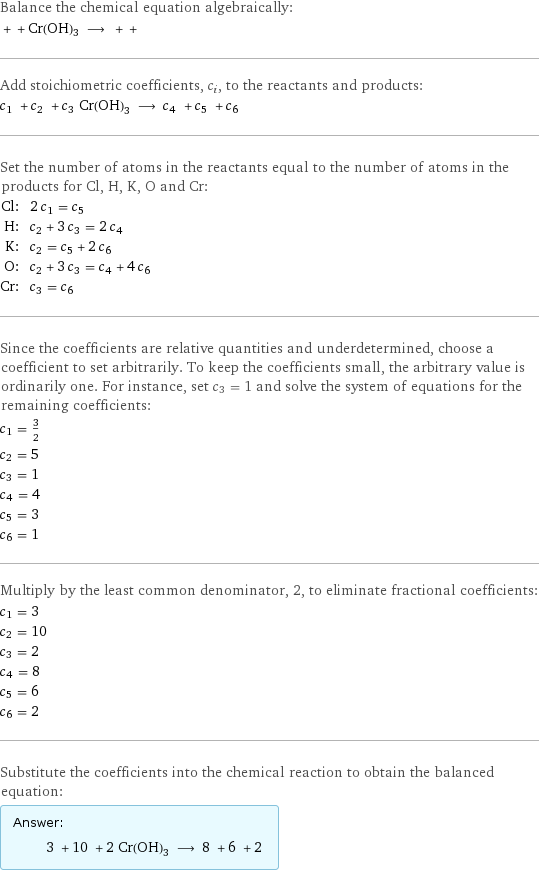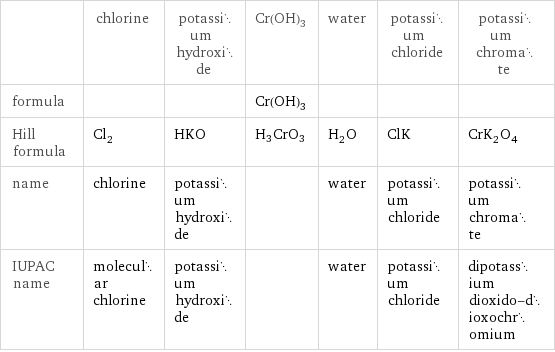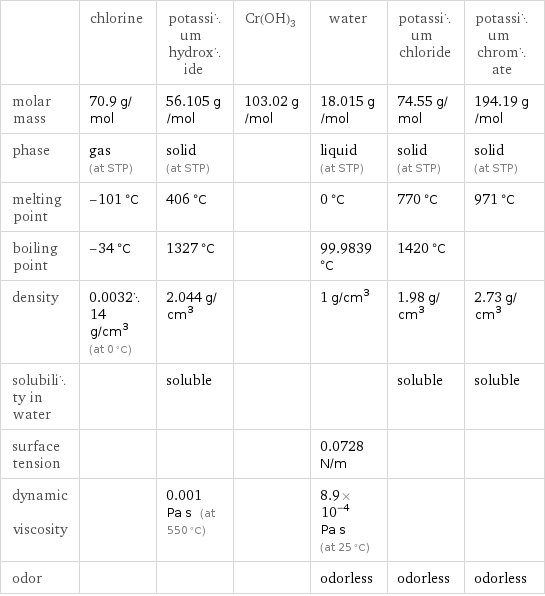Input interpretation

chlorine + potassium hydroxide + Cr(OH)3 ⟶ water + potassium chloride + potassium chromate
Balanced equation

Balance the chemical equation algebraically: + + Cr(OH)3 ⟶ + + Add stoichiometric coefficients, c_i, to the reactants and products: c_1 + c_2 + c_3 Cr(OH)3 ⟶ c_4 + c_5 + c_6 Set the number of atoms in the reactants equal to the number of atoms in the products for Cl, H, K, O and Cr: Cl: | 2 c_1 = c_5 H: | c_2 + 3 c_3 = 2 c_4 K: | c_2 = c_5 + 2 c_6 O: | c_2 + 3 c_3 = c_4 + 4 c_6 Cr: | c_3 = c_6 Since the coefficients are relative quantities and underdetermined, choose a coefficient to set arbitrarily. To keep the coefficients small, the arbitrary value is ordinarily one. For instance, set c_3 = 1 and solve the system of equations for the remaining coefficients: c_1 = 3/2 c_2 = 5 c_3 = 1 c_4 = 4 c_5 = 3 c_6 = 1 Multiply by the least common denominator, 2, to eliminate fractional coefficients: c_1 = 3 c_2 = 10 c_3 = 2 c_4 = 8 c_5 = 6 c_6 = 2 Substitute the coefficients into the chemical reaction to obtain the balanced equation: Answer: | | 3 + 10 + 2 Cr(OH)3 ⟶ 8 + 6 + 2
Structures

+ + Cr(OH)3 ⟶ + +
Names

chlorine + potassium hydroxide + Cr(OH)3 ⟶ water + potassium chloride + potassium chromate
Chemical names and formulas

| chlorine | potassium hydroxide | Cr(OH)3 | water | potassium chloride | potassium chromate formula | | | Cr(OH)3 | | | Hill formula | Cl_2 | HKO | H3CrO3 | H_2O | ClK | CrK_2O_4 name | chlorine | potassium hydroxide | | water | potassium chloride | potassium chromate IUPAC name | molecular chlorine | potassium hydroxide | | water | potassium chloride | dipotassium dioxido-dioxochromium
Substance properties

| chlorine | potassium hydroxide | Cr(OH)3 | water | potassium chloride | potassium chromate molar mass | 70.9 g/mol | 56.105 g/mol | 103.02 g/mol | 18.015 g/mol | 74.55 g/mol | 194.19 g/mol phase | gas (at STP) | solid (at STP) | | liquid (at STP) | solid (at STP) | solid (at STP) melting point | -101 °C | 406 °C | | 0 °C | 770 °C | 971 °C boiling point | -34 °C | 1327 °C | | 99.9839 °C | 1420 °C | density | 0.003214 g/cm^3 (at 0 °C) | 2.044 g/cm^3 | | 1 g/cm^3 | 1.98 g/cm^3 | 2.73 g/cm^3 solubility in water | | soluble | | | soluble | soluble surface tension | | | | 0.0728 N/m | | dynamic viscosity | | 0.001 Pa s (at 550 °C) | | 8.9×10^-4 Pa s (at 25 °C) | | odor | | | | odorless | odorless | odorless
Units
